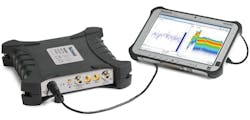However, instruments known as “signal analyzers” have also become available in recent years, with somewhat different capabilities and intended applications, including electromagnetic-compatibility (EMC) compliance testing and examining signals with complex modulation. The cost of these signal analyzers is higher than a traditional spectrum analyzer, so it helps to know when it makes sense to specify an RF/microwave signal analyzer rather than a spectrum analyzer.
Contrasting Styles
One obvious difference between a traditional spectrum analyzer and a modern signal analyzer is the type of information that must be learned about a signal of interest. A spectrum analyzer performs swept-frequency measurements across a preset portion of frequency spectrum. It measures any signals that are present at the time of the sweep, and then displays the amplitudes of all detected signals as a function of frequency. This has long been an effective means of measuring and displaying frequency-domain signal characteristics over broad bandwidths.
However, as communications signals grow in complexity, there’s greater demand for more advanced methods of measuring and analyzing the time-domain characteristics—in the manner of an oscilloscope—as well as the frequency-domain characteristics of the detected signals. Signal analyzers, which are currently available as alternative measurement tools to a traditional spectrum analyzer, offer those advanced capabilities and thus continue to gain in popularity.
For example, the vector signal analyzer (VSA) is capable of measuring the amplitude and phase of a signal of interest—not just as a function of frequency, but also as a function of time. As a result, changes in a signal’s characteristics over time, such as modulation, can be characterized.
A traditional spectrum analyzer is still a powerful tool when searching for unknown signals or evaluating the signal activity in an area and particular portion of spectrum. It also plays a key role when developing coexistence plans for multiple wireless signal sources in the same area that are closely spaced in frequency. In contrast, when using a VSA, the signal responses are typically expected if not known, and a VSA is less used as a signal search instrument.
The simplest way to think of a spectrum analyzer is as a tuned receiver with a display. An operator adjusts the tuning controls to set the range of minimum to maximum frequencies, and the bandwidth of the filter that is swept across that frequency range is also adjusted. Narrower bandwidths help to separate signals that are close together in frequency. The measurement results come as graphical depictions of signal amplitude versus frequency for a selected bandwidth.
As modern digitizers become more capable, they also assume a greater part of a spectrum analyzer’s architecture, with high-speed analog-to-digital converters (ADCs) often used to digitize an analyzer’s IF signals for further processing in the digital realm. Techniques such as fast Fourier transforms (FFTs) can be performed to develop displays of the digitized data and show different aspects of measured input signals. FFTs are the basis for real-time spectrum analyzers (RTAs), for example, which use FFTs in parallel to process a wide instantaneous bandwidth to better capture transient events.
Perhaps the simplest way to think of a signal analyzer is that it may start with a spectrum analyzer, but it adds functionality to tackle more complicated measurements, such as the measurement of phase/time possible with a VSA. Signal analyzers typically provide extensive demodulation capabilities to analyze signals with complex, digital modulation.
A spectrum analyzer can measure and display signals with analog modulation, such as amplitude modulation (AM) and frequency modulation (FM). However, a more complex signal analyzer with demodulation capabilities is needed to show signals based on digital in-phase (I) and quadrature (Q) modulation components. This is usually the realm of a VSA. Whereas a spectrum analyzer is more a tool to search for signals within a given spectral bandwidth, a VSA is designed to plot the characteristics of signals with complex modulation, such as error vector magnitude (EVM) and code domain power. A VSA is also the instrument of choice for examining modulation quality for most wireless communications standards with digital modulation.
Combination Instruments
Many modern signal analyzers are actually combinations of several instruments, such as spectrum analyzers and VSAs. They may also include real-time analyzers (RTAs), which allow measurements of signals according to precise time references. Consequently, the synchronization and timing of signals can be studied in addition to frequency, amplitude, and phase.
As an example, the CXA series of signal analyzers from Keysight Technologies (Fig. 1) can act as spectrum analyzers, but they also perform EMI measurements with a frequency range of 9 kHz to 26.5 GHz and displayed average noise level (DANL) of ‒163 dBm. These analyzers will also work with VSA software to perform measurements of phase and complex modulation, and can be fitted with a tracking generator for scalar-network-analyzer (SNA) measurements to 6 GHz.
The R&S FSW signal and spectrum analyzer (Fig. 2) from Rohde & Schwarz is a combination signal and spectrum analyzer, available with a range of instantaneous measurement bandwidths across a measurement frequency range as wide as 2 Hz to 85 GHz. It can be equipped with analysis bandwidths extending to 2 GHz for wideband modulation and pulse measurements, and features real-time analysis across bandwidths as wide as 512 MHz. Whether considered a spectrum or a signal analyzer, this instrument offers exceptional performance, with phase noise of ‒137 dBc/Hz offset 10 kHz from a 1-GHz carrier.
Another example of a multi-function instrument is the MDO4000 Series of oscilloscopes from Tektronix, which combines time-domain and frequency-domain analysis in the same instrument (Fig. 3). Though primarily an oscilloscope options add other instrument functions that include a spectrum analyzer from 9 kHz to 3 GHz or 9 kHz to 6 GHz.
The MDO4000 is well-suited for EMI troubleshooting, with an oscilloscope portion that features four analog channels with bandwidths to 1 GHz and a 5-Gsample/s maximum sampling rate. In addition to a scope and spectrum analyzer, it can be equipped with four more measurement functions: logic analyzer, protocol analyzer, arbitrary waveform generator, and digital voltmeter.
Traditional spectrum analyzers as well as modern signal analyzers no longer automatically come with display screens. As test instruments are designed into modular formats such as PXI, or with USB ports for connection to a PC, they instead use the computer’s display screens to show test results.
On that front, the RSA500A from Tektronix is a pocket-sized spectrum analyzer (Fig. 4) that connects to any USB computing device for control and display, greatly simplifying the task of making in-field measurements. In spite of the small size, it is a full-featured spectrum analyzer with frequency range of 9 kHz to either 3 GHz or 7.5 GHz, and acquisition bandwidth as wide as 40 MHz. By using a computer’s screen and processing power, it packs the measurement capabilities of a benchtop spectrum analyzer that was once about 10 times its size.





